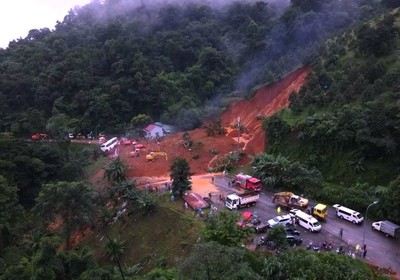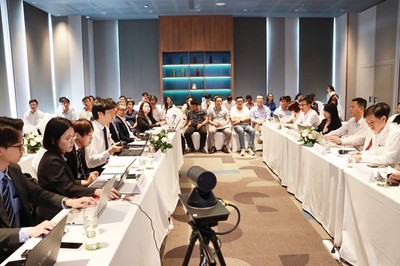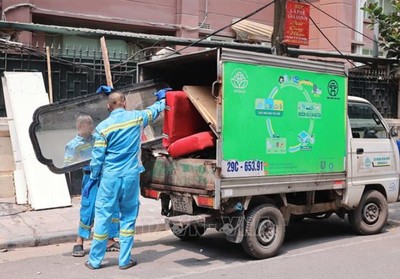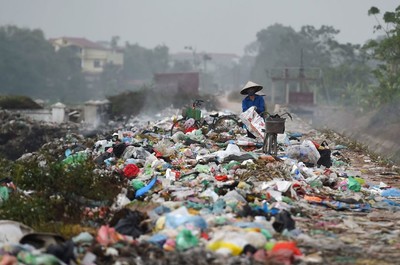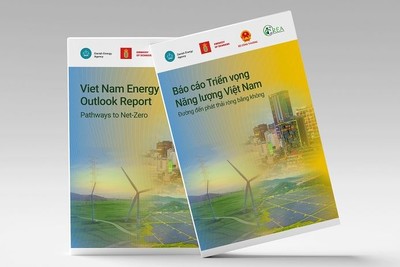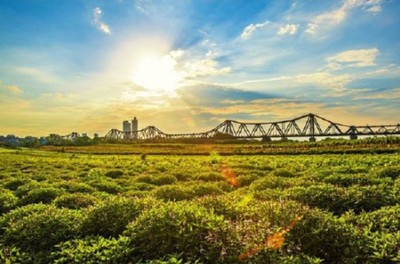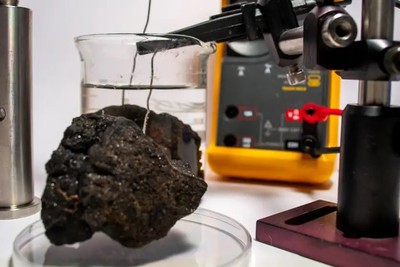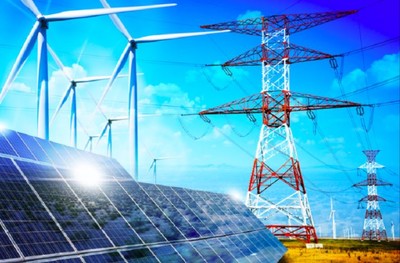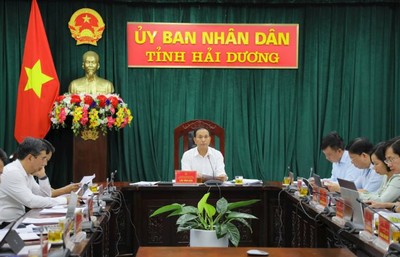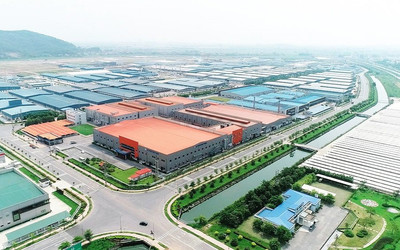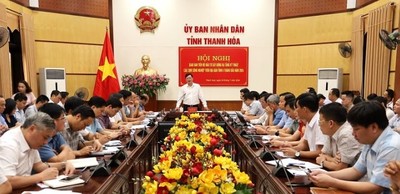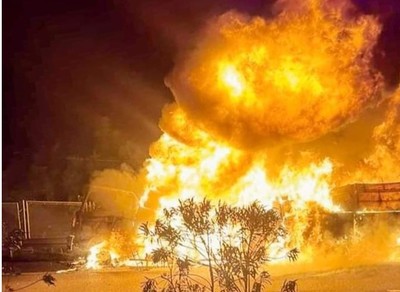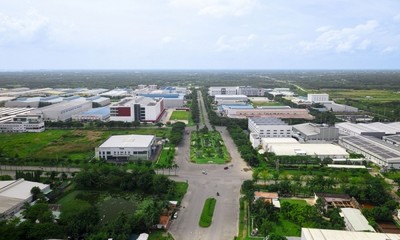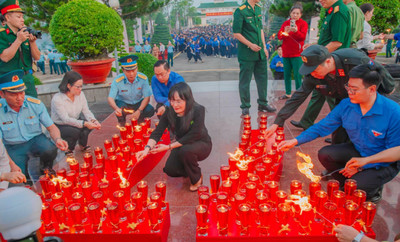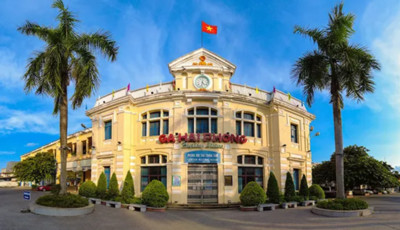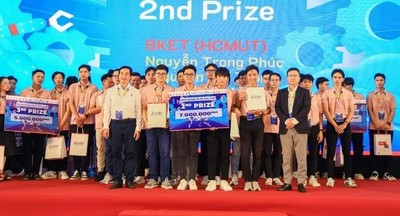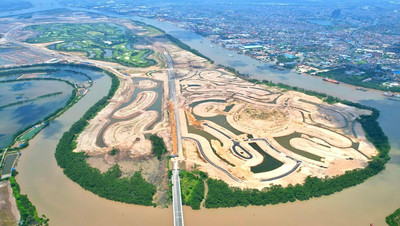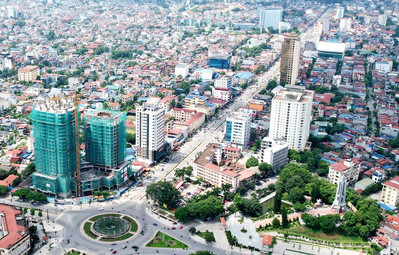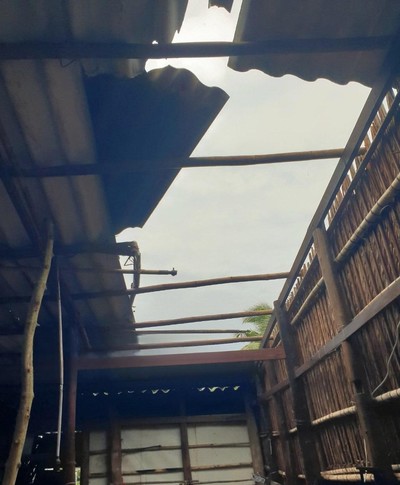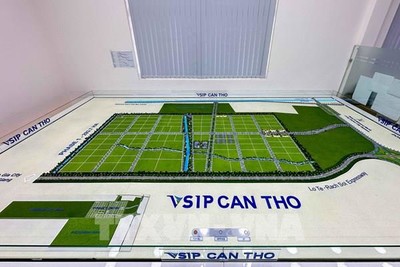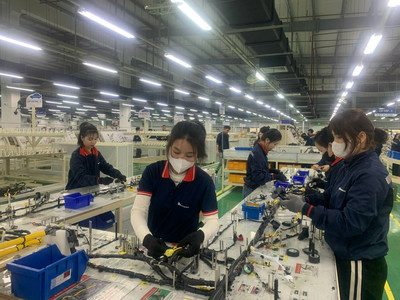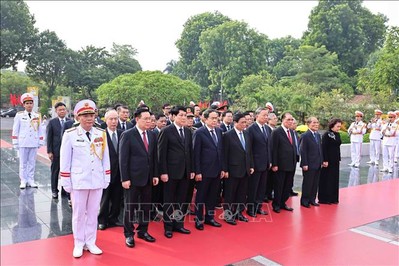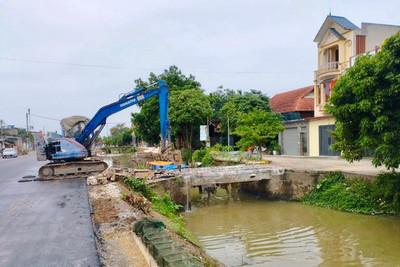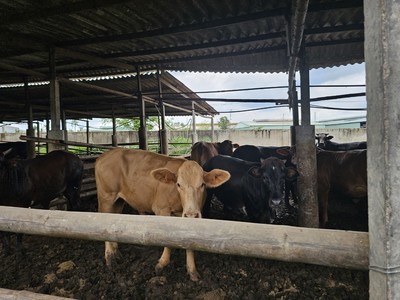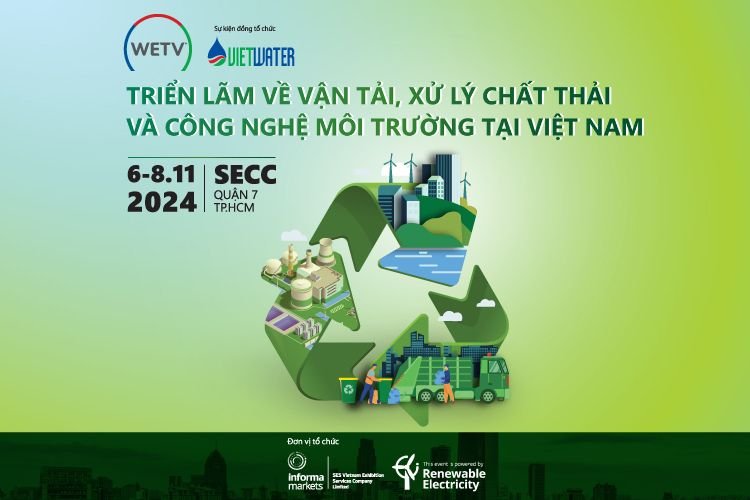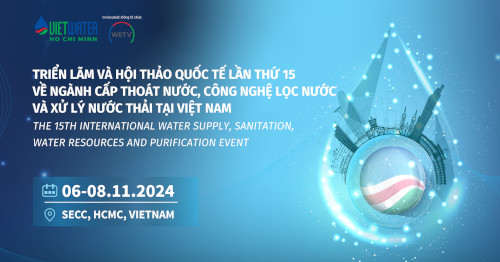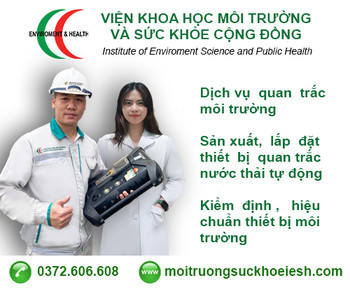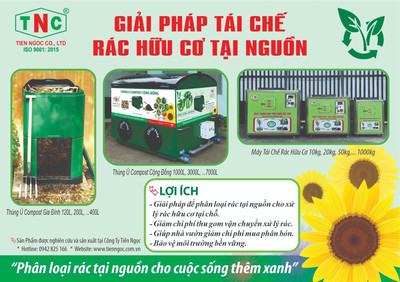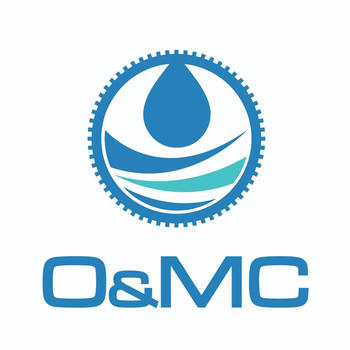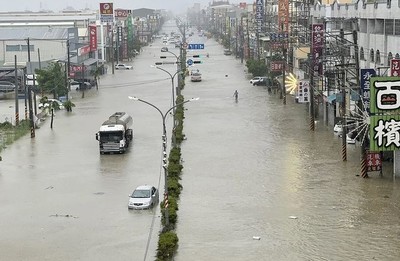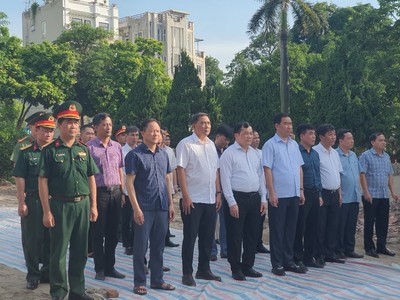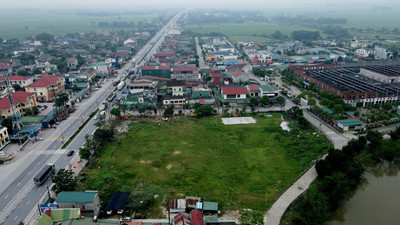Công bố quốc tế lĩnh vực môi trường số 20-2023
Trân trọng giới thiệu tới quý độc giả Công bố quốc tế lĩnh vực môi trường số 20 - 2023 với những nội dung chính như sau:
Về quản lý môi trường
- Nghiên cứu về chỉ số độ nhạy hình thành ôzôn của bốn cụm đô thị của Trung Quốc bằng cách sử dụng dữ liệu vệ tinh của Công cụ giám sát ôzôn (OMI) và các phép đo trên mặt đất
- Mối quan hệ giữa ô nhiễm không khí liên quan đến giao thông và dấu ấn sinh học viêm bằng cách sử dụng mô hình phương trình cấu trúc
- Các chất đánh dấu hóa học và sinh học để xác định nguồn và đường vận chuyển ô nhiễm hệ thống tự hoại đến các dòng suối ở những khu vực có đất thấm thấp
- Tối ưu hóa các không gian vận hành an toàn và công bằng ở quy mô tiểu lưu vực để hướng dẫn quản lý môi trường địa phương
- Phương pháp suy luận thống kê cho các tiêu chí chứng nhận các-bon thấp của sản phẩm nông nghiệp của Hàn Quốc để phản ánh các điều kiện không chắc chắn
- Sự tham gia tích cực vào môi trường, xã hội và quản trị có gây ra rủi ro cho công ty không? Vai trò điều tiết của bồi thường điều hành
- Tăng cường khả năng phục hồi của các dịch vụ hệ sinh thái trước các sự kiện cực đoan trong các hệ thống thủy văn - xã hội: Phân tích không gian - thời gian
- Giải quyết ô nhiễm nước lan tỏa từ nông nghiệp: Cơ cấu quản trị có quan trọng đối với bản chất của các biện pháp được thực hiện không?
- Xây dựng thành phố carbon thấp có thể giảm cường độ carbon không? Bằng chứng thực nghiệm từ chính sách thí điểm thành phố carbon thấp ở Trung Quốc
Về môi trường đô thị
- Lập bản đồ phân bố không gian của đảo nhiệt đô thị về đêm dựa trên khung Vùng Khí hậu Địa phương
- Không gian xanh đô thị và tính bền vững: khám phá các dịch vụ hệ sinh thái và sự tàn phá của bãi cỏ so với đồng cỏ hoa
- Phát hiện thay đổi đối tượng đô thị 3D từ các đám mây điểm trên không và trên mặt đất: Đánh giá
- Định lượng thông qua học sâu về yếu tố bầu trời và cây xanh trên đường đô thị trong mùa nóng và mùa mát
- Đánh giá rủi ro sức khỏe của cư dân châu Âu tiếp xúc với vật chất dạng hạt xung quanh bị ô nhiễm bởi các nguyên tố có khả năng gây độc
- Đặc điểm và khả năng ô nhiễm của nước rò rỉ từ các bãi chôn lấp chất thải rắn đô thị: Các ví dụ thực tế từ Ba Lan và Cộng hòa Séc và đánh giá toàn diện trong bối cảnh toàn cầu
- Nguy cơ định hướng nguồn và diện tích bề mặt lắng đọng phổi (LDSA) của các hạt siêu mịn ở khu vực đô thị Đông Nam Á
- Điều kiện thủy văn của Hồ Baiyangdian có thể hỗ trợ một đô thị đang bùng nổ không?
- Tương tác giữa đô thị hóa và sử dụng đất dự đoán ô nhiễm kháng sinh trong đất giữa các vùng nông thôn thành thị
- Ô nhiễm hạt vi nhựa trong trầm tích hệ thống thoát nước mưa đô thị
Về môi trường khu công nghiệp
- Xanh hóa ngành công nghiệp: Cơ hội và thách thức trong tiếp cận điện năng cho các doanh nghiệp công nghiệp Na Uy
- Phương pháp tiếp cận lượng khí thải carbon thấp để sản xuất bê tông đầm nén tái chế
- Cảnh quan đô thị và ngành công nghiệp kế thừa cung cấp các điểm nóng về khí nhà kính ven sông: Một nghiên cứu từ nguồn tới biển của sông Clyde
- Chất xúc tác quang sơ đồ S g-C3N4/AgBiS2 được điều khiển bằng ánh sáng khả kiến để cố định N2 và phân hủy rhodamine B
- Chất thải công nghiệp kiềm – Đặc điểm, rủi ro môi trường và tiềm năng quản lý chất thải mỏ
- Một cách tiếp cận tích hợp để định lượng phân bổ nguồn và nguy cơ sức khỏe định hướng theo nguồn của kim loại nặng trong đất gần khu công nghiệp cũ
- Quản lý nước thải trong các nhà máy RO cộng đồng phi tập trung bằng cách đưa ra sơ đồ xử lý tích hợp NF và RO bằng phân tích quy mô thí điểm
- Sục khí vi mô hỗ trợ hô hấp điện tăng cường quá trình dị hóa vi sinh vật và amon hóa các amin thơm trong nước thải công nghiệp
- Tín dụng xanh và năng suất nhân tố xanh công nghiệp xanh: Cơ chế tác động và kiểm định hiệu ứng ngưỡng
- Khử cacbon và tích hợp hydro trong ngành thép: Sự phát triển, thách thức và phân tích kinh tế kỹ thuật gần đây
- Đổi mới bền vững trong lĩnh vực công nghệ thấp và trung bình: Bằng chứng từ một doanh nghiệp vừa và nhỏ trong ngành da giày
- Đặc tính và khả năng định giá của chất thải chế biến thực phẩm công nghiệp
Xin trân trọng giới thiệu!
QUẢN LÝ MÔI TRƯỜNG
1. Field experiments to assess the remediation efficiency of metal-contaminated soil by flushing with ferric chloride followed by applying amendments
Science of The Total Environment, Volume 868, 10 April 2023, 161592
Abstract
The Cd, Cu, Pb, and Zn removal efficiencies achieved by flushing with FeCl3 were determined in a field experiment using soil contaminated with multiple metals. Soil was first flushed with FeCl3 and then with FeCl3 or a mixture of chelators. Flushed soil was amended with lime and organic matter to revitalize the soil, then the soil was used to grow Zea mays and Brassica juncea. The heavy metal concentrations in groundwater were determined to assess the risks of leaching caused by soil flushing. The Cd, Cu, Pb, and Zn removal efficiencies were 70%, 40%, 33%, and 17%, respectively, when FeCl3 (25 mmol (kg topsoil)−1) was applied.
The second washing generally did not significantly decrease the heavy metal contents of the soil but the second FeCl3 washing did decrease the Pb content. Pb leached from topsoil was partly retained by the subsoil 20–40 cm deep. The Zea mays yields were significantly lower but the Brassica juncea yields were significantly higher after the combined soil flushing and amendment treatment than after only the amendment treatment. This indicated that soil flushing only negatively affected growth of deep-rooted Z. mays. The Cd, Cu, Pb, and Zn concentrations in Z. mays grains and the edible parts of B. juncea grown in remediated soil were below the Chinese tolerable limits for contaminants in food. Washing with FeCl3 did not increase groundwater contamination during the study. The results indicated that flushing soil with FeCl3 and subsequent amendments is a technically feasible method for remediating agricultural soil contaminated with Cd.
2. Different types of land use influence soil physiochemical properties, the abundance of nitrifying bacteria, and microbial interactions in tropical urban soil
Science of The Total Environment, Volume 869, 15 April 2023, 161722
Abstract
Anthropogenic activities have led to unexpected changes in microbial community composition and structure, resulting in an interruption of soil ecological roles in urban environments. We questioned the impact of the different land use (e.g., agricultural, industrial, recreational, coastal, and residential areas) on the distribution of nitrifying bacteria and microbial interaction in tropical soil. The dominant nitrifying bacteria were ammonia-oxidizing archaea (AOA) in tropical soils up to 107 copies/g of soil, while the abundance of ammonia-oxidizing bacteria (AOB) was significantly higher in agricultural soil only. Comammox (CMX) was ubiquitous up to 105 copies/g of tropical soil, indicating that CMX might share ecological niches with AOA and considerably contribute to nitrification in urban areas. The most abundant phylum is Actinobacteria, accounting for 27–34 % relative abundance among most land-use types, but Proteobacteria was observed as the most prevalent phylum in agricultural soil.
The physicochemical properties (e.g., soil pH and nutrient contents) of different types of land use influenced microbial richness and diversities associated with nitrogen cycling. Multivariate analysis disclosed that agricultural soils were distinct from other land uses because of the concentrations of nutrients and heavy metals and the abundance of microorganisms associated with nitrogen cycles. Also, the microbial co-occurrence network revealed that agricultural soils were a highly interconnected network of the microbial community. In this study, C: N ratio might have a significant impact on ecological networks and the abundance of nitrogen-related taxa, which could influence microbial interactions and complexity in tropical soils. Thus, the impact of anthropogenic land use induced changes in microbial composition and diversity, co-occurrence network, and nitrifying bacteria, leading to potential transformation in ecological services of tropical soils and nitrogen cycling in urban environments.
3. Research on the ozone formation sensitivity indicator of four urban agglomerations of China using Ozone Monitoring Instrument (OMI) satellite data and ground-based measurements
Science of The Total Environment, Volume 869, 15 April 2023, 161679
Abstract
Near surface ozone is a typical secondary pollutant, and is mostly generated by a series of complex photochemical reactions of volatile organic compounds (VOCs) and nitrogen oxides (NOx) in the air under sunlight. At present, a large number of studies have applied FNR (a ratio of formaldehyde (HCHO) to nitrogen dioxide (NO2) retrieved by satellite) indicator to study the ozone formation sensitivity (OFS). OFS analysis is critical for taking targeted ozone pollution prevention and control measures. Regional OFS can be more accurately diagnosed by utilizing localized FNR threshold. In this study, localized FNR thresholds were established for four severe ozone polluted urban agglomerations in China (Beijing-Tianjin-Hebei (BTH) region, Yangtze River Delta (YRD) region, Pearl River Delta (PRD) region, and Chengdu-Chongqing (CY) region), based on the statistical analysis between FNR (obtained from OMI observation, with daily transit time of approximately 13:45 local standard time) and ΔO3/ΔNO2 (the ratio of ozone change to nitrogen dioxide change between two consecutive months, obtained from ground measurements) from 2014 to 2016.
And these thresholds were verified by the statistical analysis between FNR and ΔO3/O3 (ozone change rate between two consecutive months), and between FNR and O3 concentration during the OFS significant shift months. Furthermore, the results were also compared and verified with the method proposed by previous studies. The results indicate that there are significant regional dependences in the FNR threshold, and the lower–upper limits for the four urban agglomerations are as follows: 0.65–1.21 for BTH, 0.64–1.48 for the YRD, 1.25–2.39 for the PRD, and 1.44–3.69 for CY (FNR < lower limit indicates VOCs-limited regime; lower limit < FNR < upper limit indicates transitional regime; FNR > upper limit indicates NOx-limited regime). This method eliminates the problems associated with the undifferentiated use of FNR thresholds in different regions and significantly reduces the deviations for OFS.
4. Chemical and biological tracers to identify source and transport pathways of septic system contamination to streams in areas with low permeability soils
Science of The Total Environment, Volume 870, 20 April 2023, 161866
Abstract
Septic systems are widely used in rural areas that lack centralized sewage treatment systems. Incomplete removal of domestic wastewater contaminants in septic systems can lead to leaching of nutrients (P and N), bacteria/viruses, and trace contaminants to surrounding groundwater and surface water. This study focuses on delineating the fate of wastewater contaminants in localities where septic systems are installed in moderate to fine-grained overburden materials to assess potential impacts on groundwater and surface water quality in these settings. Nutrients and a suite of anthropogenic tracers, including host-specific fecal indicator bacteria (bovine- and human-specific Bacteroides), pharmaceutical compounds (caffeine, carbamazepine, gemfibrozil, ibuprofen, naproxen, and sulfamethoxazole), and an artificial sweetener (acesulfame-K), were selected to evaluate differences in transport properties. Surface water samples (n = 103) were collected from streams upstream (US) and downstream (DS) of three rural hamlets up to two times monthly over one year. Results indicate the presence of wastewater indicators in the streams, with DS locations showing significantly elevated concentrations of both chemical and biological anthropogenic tracers.
Human-specific Bacteroides, caffeine, and acesulfame-K were consistently observed at elevated concentrations at all DS sites. Nutrients exhibited varied concentrations between US and DS locations at three study sites. The occurrence of human-specific Bacteroides in the surface water samples suggests the presence of preferential flow pathways within the silt/clay overburden. These results demonstrate the advantages of using a combined tracer approach, involving a conservative tracer such as acesulfame-K coupled with the human-specific biological indicator Bacteroides (BacHum), to understand not only impacting sources but also potential transport pathways of septic system contamination to nearby streams. Septic systems may be an underappreciated contaminant source in rural hamlets located in fine-grained overburden materials; although, a distinction of specific nutrient sources (septic systems vs. agriculture) remains challenging.
5. Relationship between traffic-related air pollution and inflammation biomarkers using structural equation modeling
Science of The Total Environment, Volume 870, 20 April 2023, 161874
Abstract
Background
Evidence suggests that exposure to traffic-related air pollution (TRAP) and social stressors can increase inflammation. Given that there are many different markers of TRAP exposure, socio-economic status (SES), and inflammation, analytical approaches can leverage multiple markers to better elucidate associations. In this study, we applied structural equation modeling (SEM) to assess the association between a TRAP construct and a SES construct with an inflammation construct.
Methods
This analysis was conducted as part of the Community Assessment of Freeway Exposure and Health (CAFEH; N = 408) study. Air pollution was characterized using a spatiotemporal model of particle number concentration (PNC) combined with individual participant time-activity adjustment (TAA). TAA-PNC and proximity to highways were considered for a construct of TRAP exposure. Participant demographics on education and income for an SES construct were assessed via questionnaires. Blood samples were analyzed for high sensitivity C-reactive protein (hsCRP), interleukin-6 (IL-6), and tumor necrosis factor-α receptor II (TNFRII), which were considered for the construct for inflammation. We conducted SEM and compared our findings with those obtained using generalized linear models (GLM).
Results
Using GLM, TAA-PNC was associated with multiple inflammation biomarkers. An IQR (10,000 particles/cm3) increase of TAA-PNC was associated with a 14 % increase in hsCRP in the GLM. Using SEM, the association between the TRAP construct and the inflammation construct was twice as large as the associations with any individual inflammation biomarker. SES had an inverse association with inflammation in all models. Using SEM to estimate the indirect effects of SES on inflammation through the TRAP construct strengthened confidence in the association of TRAP with inflammation.
Conclusion
Our TRAP construct resulted in stronger associations with a combined construct for inflammation than with individual biomarkers, reinforcing the value of statistical approaches that combine multiple, related exposures or outcomes. Our findings are consistent with inflammatory risk from TRAP exposure.
6. Optimizing safe and just operating spaces at sub-watershed scales to guide local environmental management
Journal of Cleaner Production, Volume 398, 20 April 2023, 136530
Abstract
The safe and just operating space (SJOS) concept provides a promising framework tool to help guide social-ecosystem management and sustainable global development goals (SDGs). Due to spatial differences in geographic background and economic development, proportioning these elements according to global, regional and local scales is a necessity for sustainability governance.
Achieving SDG targets requires guidance according to SJOS environmental and social boundaries. Here, integrating planetary boundaries (PBs) with the SJOS framework is explored and focused towards the sub-watershed scale in the Chaohu watershed, China. Assessment of environmental and socio-economic dimension changes in this watershed incorporates data taken from long-term monitoring, surveys and anthropogenic impact records in lake sediment sequences. These are used to explore spatial and temporal differences in key environmental change processes and social well-being measures in the watershed. The interrelationships with identified prioritized PB limitation indicators within the sub-watersheds were evaluated numerically. Results indicate four PB biogeophysical dimensions, water quality, chemical pollution, air pollution and ozone depletion all operate in the Chaohu watershed and exceed safe boundary limits. However, large differences exist between the four main sub-watersheds. Environmental pressures in the two western sub-watersheds are considerably greater than those in eastern regions.
Most social indicators selected for the whole watershed conform well to PB limits considered necessary for achieving sustainable development goals (SDGs), especially food (SDG 2), health (SDG 3), sanitation services (SDG 6c) and consumption (SDG 12). Based on quantifiable environmental change trends in each sub-watershed and social development in the last decades, we identify, water quality, chemical pollution, and soil stability PB dimensions as exceeding safe operation limits.
These dimensions are prioritized for environmental management and harmonization with SDG targets. Water utilization intensity (SDG 6a) and forest cover (SDG 15) are social development priorities across the whole Chaohu watershed. Redundancy analysis identified GDP per capita as well as changes in forest and vegetation cover as key drivers of environmental degradation throughout the watershed. While not all 17 SDGs are considered, initial results of this study provide a rational base for informing systems management and policy, guiding the attainment of SDG targets, and communicating the importance of revealing environmental change trends. Requirements for sustainable development of human society locally and regionally are, within limits of the data available, identified by matching SJOS boundaries with SDG targets. Strengthening time-track data for the key drivers of change and combining with emerging socio-economic factors is needed to better define specific SDG progress in terms of achieving calibrated environmental boundaries.
7. Statistical inference method for Korean low-carbon certificate criteria of agricultural products to reflect uncertain conditions
Journal of Cleaner Production, Volume 398, 20 April 2023, 136425
Abstract
Strengthened regulations and standards related to climate change, including upgrading the emission reduction targets of developed countries based on the Paris Agreement (UNFCCC, 2015), have led to voluntary and active countermeasures such as certification systems in various fields (Kang et al., 2012). By 2030, South Korea (Korea, hereafter) will be required to reduce GHG emissions by 7.9% (about 1.9 million metric tons CO2e) compared to business as usual (BAU) in the agriculture, forestry, and livestock industries. These industries account for about 2.9% of the total GHG emissions in Korea (Bae, 2015; Ha et al., 2019; Kafle et al., 2017; NCGIR). To meet this goal, the Korean government has promoted various efforts since 2012 to reduce GHG emissions such as developing low-carbon agricultural technologies, implementing voluntary emission reduction projects in agriculture and farms, and introducing a low-carbon agricultural product certification system (RDA and Jeonju, 2013).
8. Does aggressive environmental, social, and governance engagement trigger firm risk? The moderating role of executive compensation
Journal of Cleaner Production, Volume 398, 20 April 2023, 136542
Abstract
Drawing on stakeholder and agency theories, we analyzed whether optimum and aggressive environmental, social, and governance engagement alleviates/exacerbates firm risk with the moderating effect of executive compensation. We distinguished optimum and aggressive environmental, social, and governance engagement via a separate research model and subsequently applied the generalized method of moments based on 43,803 observations between 2002 and 2019. We found that while optimum environmental, social, and governance engagement is negatively associated with firm risk, aggressive environmental, social, and governance engagement is positively associated with firm risk. However, the moderating effect of executive compensation significantly weakened the positive association between aggressive environmental, social, and governance engagement and firm risk. Hence, corporate social responsibility contracting is key to reconciling the interests of stakeholders and shareholders.
9. Ecological damage claim program and environmental violations: Evidence from a quasi-natural experiment in ChinaJournal of Cleaner Production
Volume 397, 15 April 2023, 136520, Journal of Cleaner Production
Abstract
Whether the ecological damage claim program can resolve negative institutional and intergenerational externalities for pollution matters for sustainable development. We employ a difference-in-differences model and data on a panel of listed firms in heavily polluting industries from 2012 to 2017 to examine the effects of China's ecological damage claim pilot policy on corporate environmental violations. Our results show that the policy significantly decreased environmental violations by firms in the pilot cities compared to those in non-pilot cities. We examined whether environmental enforcement and compliance rates influenced violations and mitigated negative institutional and intergenerational externalities. We found that the policy also produced a deterrent effect on other firms. In addition, we found that the ecological claim policy performed better in areas with high levels of enforcement and environmental attention. We found also that more independent firms and firms with a larger environmental performance gap were more proactive.
10. Enhancing the resilience of ecosystem services under extreme events in socio-hydrological systems: A spatio-temporal analysis
Journal of Cleaner Production, Volume 397, 15 April 2023, 136437
Abstract
Due to the adverse impacts of severe droughts on various aspects of human life and ecosystem services (ESs), the spatio-temporal assessment of the resilience of ESs under droughts is essential. In this paper, we propose a new methodology for assessing ESs-based resilience, taking into account the seven resilience principles: a) redundancy and diversity, b) managing connectivity, c) managing slow variables and their feedback, d) complex adaptive system (CAS) thinking, e) experimentation and learning, f) broadening participation, and g) polycentric governance. These principles enable us to consider the main social, political, hydrological, economic, and environmental aspects concerning resilience which have been overlooked in previous studies. The methodology is evaluated by applying it to Zarrinehroud River Basin (ZRB) in north-western Iran.
A set of qualitative and quantitative criteria and their sub-criteria are proposed for quantifying the ES-based resilience and generating time series of resilience against severe droughts in several sub-basins in the study area. To evaluate the criteria and sub-criteria, the required data are derived from calibrated SWAT and MODSIM models as well as experts’ judjments.
The time series of ES-based resilience under 128 Water and Environmental Resources Management (WERM) scenarios (for enhancing agricultural practices, altering and modernizing irrigation methods, improving irrigation network and drainage facilities) and Climate Change (CC) scenarios (RCP 4.5, RCP6.0, and RCP 8.5) are derived for each sub-basin based on short-term (2020–2049) and long-term (2020–2098) periods.
The low resilience values (0.53–0.6) of all sub-basins under the base management scenario (the status quo scenario (SC0)) illustrate the need for implementing some projects to enhance the ESs in the study area. The results show that the WERM scenario SC12346 can improve the values of the resilience criterion in sub-basins up to 0.85 and reduce the vulnerability of the study area to droughts.
By evaluating all management scenarios, scenario SC12346 is reported as the best scenario, since it can significantly increase the resilience of all sub-basins against extreme droughts with an acceptable cost of 636 million US dollars compared to other scenarios. Under this WERM scenario, the resilience values of sub-basins increase up to 40%. This scenario suggests implementing a set of projects such as improving irrigation networks and drainage facilities.
11. Drivers of eco-environmental quality in China from 2000 to 2017
Journal of Cleaner Production, Volume 396, 10 April 2023, 136408
Abstract
Intense human activity and severe climate change in China have imposed significant burdens on eco-environmental quality (EEQ) and caused great challenge to achieve the Sustainable Development Goals. However, the response mechanism of China's EEQ to natural factors and human activities in recent decades has remained unclear. Here, we combined multi-source remote sensing data, reanalysis data and model data, based on the Theil-Sen Median, TSS-RESTREND and Hurst index, to reveal the characteristics of past and future EEQ changes in China and to explore the driving factors of its changes from the perspective of natural factors and human activities.
Over the last 18 years, the EEQ of more than 60% of the area has increased. Using TSS-RESTREND analysis, we found that human activities and natural factors jointly dominanted about 58% of the EEQ in China. Natural factors simultaneously dominated the EEQ changes in more than 80% of the area, with climate water deficit being the most important. Three human activities of the population, gross domestic product, and electricity consumption have increased significantly in the past 18 years, simultaneously dominating the EEQ change in about 18% of the areas in China. Accordingly, in the context of global climate change, rational exploitation of human activities is essential to China's EEQ. Accordingly, a comparative analysis of the drivers of EEQ in China provides a scientific basis for understanding and optimising management policies.
12. Monitoring the enterprise carbon emissions using electricity big data: A case study of Beijing
Journal of Cleaner Production, Volume 396, 10 April 2023, 136427
Abstract
Enterprises are major sources of anthropogenic carbon emissions, and high-quality data on enterprise carbon emissions are prerequisites for climate abatement policies and actions. However, most of the existing data are more than one-year lagging, easily manipulated, and concentrated at the industrial or regional level. To bridge these gaps, this study develops a monitoring approach for enterprise carbon emissions by combining electricity big data, bottom-up emission accounting model, and network model.
The proposed approach has then been applied to monitor the real-time carbon emissions of 0.81 million enterprises in Beijing. Our major findings are that: (1) Owing to a large amount of embodied carbon emissions from electricity inflow, Beijing's electricity-related CO2 emissions are 73.57 million tonnes in 2020, constituting 55% of its total. (2) The CO2 emissions per kWh of electricity consumed in Beijing is 645.26 g, whose top three traceable contributors are Hebei (206.71 g), Shanxi (142.21 g), and Beijing itself (133.07 g). (3) The average monitoring error of enterprise carbon emissions is less than 7%, proving the effectiveness of the proposed approach using electricity big data.
13. Balancing economic development and construction waste management in emerging economies: A longitudinal case study of Shenzhen, China guided by the environmental Kuznets curve
Journal of Cleaner Production, Volume 396, 10 April 2023, 136547
Abstract
A common dilemma in emerging economies is how to balance economic development and environmental protection. This dilemma is particularly evident in the construction industry, which materializes housing and infrastructure for economic development while generating huge amou of construction waste, which, if not properly managed, could lead to serious environmental degradation. This study aims to explore useful strategies for balancing economic development and construction waste management (CWM) in emerging economies. It does so by adopting a mixed-method approach organized in a longitudinal case study of Shenzhen, China; an emerging economy that has successfully balanced the two goals. Firstly, based on quantitative data, an environmental Kuznets curve (EKC) is developed to indicate Shenzhen's dynamic evolvement of economic development and CWM over time.
Then, qualitative research is conducted to understand the experiences behind Shenzhen's EKC evolvement. These experiences are distilled into: (1) strong economic support, (2) strong government interventions, (3) a thriving recycling market, (4) advanced recycling technologies, and (5) making use of major events as a catalyst. This study provides a useful reference for the dilemma of economic development and CWM in emerging economies and for deployment of proper strategies to address this dilemma.
14. Interprovincial differences in the historical peak situation of building carbon emissions in China: Causes and enlightenments
Journal of Environmental Management, Volume 332, 15 April 2023, 117347
Abstract
Scientific assessment of the historical carbon peak situation of provincial buildings in China is the premise and basis for understanding the country's development trends and formulating carbon peak goals. The population size, urbanization stages, economic development levels, natural resources endowment, and energy structure characteristics vary significantly for the different provinces in China, resulting in significant differences in the peaking situation of building carbon emissions (BCE).
The differences require more attention given the current environmental status. Based on the judgment function of carbon peaking conditions and the statistical Mann-Kendall (MK) trend test method, this study evaluates the historical peak situation of building carbon emissions at the provincial level in China. The peaking sequence of BCE, building carbon emissions per capita (BCEP), and carbon emissions per unit floor area (BCEA) were analyzed, and the driving factors that cause different carbon peak situations were discussed. Further, with reference to the experience of the United States, a peak strategy for building carbon emissions in China was proposed. The research results showed that BCE in Beijing and Yunnan have peaked, and the three provinces of Shanghai, Sichuan, and Hubei have plateaued.
The most important factors that cause different peaking situations for BCE are the floor area per capita and carbon emissions per unit of energy consumption. In addition, the peak order of building carbon emissions was BCEA, BCEP, and BCE. A strategy that should be adopted in the promotion of buildings' carbon peak in China is to formulate phased peak goals for BCE, BCEP, and BCEA at a national level and differentiated echelon peak goals at a provincial level considering interprovincial differences. This study provides a scientific basis and decision-making reference for formulating a path to buildings' carbon peak at a provincial level in China.
15. Addressing diffuse water pollution from agriculture: Do governance structures matter for the nature of measures taken?
Journal of Environmental Management, Volume 332, 15 April 2023, 117329
Abstract
Nutrient pollution of freshwaters from agriculture is a key barrier to achieving the water quality goals of the European Water Framework Directive (WFD). Governance research suggests that governance structures can support the planning of water quality measures. However, it is widely unclear how specific governance structures affect the actual nature of practical measures taken for addressing the "wicked problem” of diffuse nutrient pollution.
This study analyses how the extent of consensual policy styles, organizational and program integration, participatory governance, and the capacities of public authorities are related to the substance of practical measures taken (effect-vs. source-based measures) and the choice of policy instruments (e.g., sermons, carrots, sticks). Based on a comparative case study design including six country cases, document analyses, and expert interviews, we find no clear-cut relationships between the country's governance structures and the types of measures chosen or any trend of a combined effect. This suggests that, in the case of the WFD, governance structures are less important than expected or that different governance structures compensate for the effects on the level of practical measures taken and policy instruments chosen. These results question the dominant assumption that these governance structures matter (a lot) in wicked problem solving and may hint to additional context factors these governance structures are embedded in.
16. Can low-carbon city construction reduce carbon intensity?Empirical evidence from low-carbon city pilot policy in China
Journal of Environmental Management, Volume 332, 15 April 2023, 117363
(NAS) framework and the social-ecological systems (SES) framework. We thus perform an integrative and interpretative narrative review to draw a richer and more nuanced picture of PIs: their potential impacts, their (institutional and behavioural) mechanisms and challenges, and caveats and recommendations for their design and implementation. Our review shows that PIs can indeed foster collective action by (a) helping the relevant actors craft suitable and legitimate institutional arrangements and (b) addressing and/or influencing actors' attributes of relevance to collective action, namely their individual and shared understandings, beliefs and preferences.
To fulfil this potential, the organisers and sponsors of PIs must address and link to the broader context through soundly designed and implemented processes. Complementary follow-up, enforcement and conflict resolution mechanisms are necessary to nurture, reassure and sustain understandings, beliefs and preferences that undergird trust-building and collective action. The conceptual framework developed for the review can help researchers and practitioners further assess these insights, disentangle PIs' mechanisms and impacts, and integrate the research and practice of participatory governance and collective action.
MÔI TRƯỜNG ĐÔ THỊ
1. Urbanization–land-use interactions predict antibiotic contamination in soil across urban–rural gradients
Science of The Total Environment, Volume 867, 1 April 2023, 161493
Abstract
Antibiotics ubiquitously occur in soils and pose a potential threat to ecosystem health. Concurrently, urbanization and land-use intensification have transformed soil ecosystems, but how they affect antibiotic contamination remain largely unknown. Therefore, we profiled a broad-scale pattern of antibiotics in soil from agricultural lands and green spaces across urbanization gradients, and explored the hypothetical models to verify the effects of urbanization and land-use intensity on antibiotic contamination. The results showed that antibiotic concentrations and seasonality were higher in agricultural soil than in green spaces, which respectively showed linear or hump-shaped declines along with the increasing distance to urban centers. However, the response of antibiotic pollution to land-use intensity depended strongly on the urbanization level.
More importantly, interactions between urbanization and land-use explained, on average, 59.6 % of the variation in antibiotic concentrations in soil across urbanization gradients. The proposed interactions can predict the non-linear changes in soil vulnerability to antibiotic contamination. Our study revealed that the urbanization can modulate the effects of land-use intensity on antibiotic concentration and seasonality in the soil environment, and that there is high stress on peri-urban soil ecosystems due to ongoing land-use changes arising from rapid urbanization processes.
2. Microplastic pollution in sediments of urban rainwater drainage system
Science of The Total Environment, Volume 868, 10 April 2023, 161673
Abstract
The sink of microplastics (MPs) in sediments of urban rainwater drainage system (RDS) is of great concern, because the MPs deposited can be resuspended by flow disturbance. Previous research has confirmed the significant accumulation of MPs in sediments of urban RDS, but it remains poorly elucidated, such as pollution sources and influencing factors. In this study, we investigated the MPs in sediments from RDS of a university campus. MPs were detected from all sediment samples, showing the ubiquity of microplastic pollution. Among 11 samples MPs' abundance ranged from 80 to 2610 particles/kg (dry weight), with highly spatial variability, depending on land type and environmental management practice within the catchment. Sites from office & teaching area had the averaged abundance of 335.00 ± 196.85 particles/kg, while 270.00 ± 89.09 particles/kg for staff residential area, and 795.00 ± 1050.65 particles/kg for student living area, indicating that the sediments of RDS from student living area had the highest abundance of MPs. However, independent sample t-test analysis suggests there is no statistically significant difference between land types, because of effective environmental management practices in the catchment.
The surfaces of MPs were much rough, which implies that the fragmentation of larger plastic particles resulted in the production of MPs. Although the MPs of <1000 μm were the most, 1000–2000 μm MPs also accounted for a significant proportion in this study, showing a slight difference from the previous study in which MPs over 1 mm were quite low. Polypropylene (PP) and polyester (PET) found to be dominant with 49.75 ± 18.69 % and 49.75 ± 18.69 % of the total number, respectively. As to shapes, the proportion of fiber and fragment MPs exceeded 80 %. The color of MPs diversified greatly, and the MPs with bright colors occupied over 80 %. Fabric fibers, food packaging and courier packaging materials were figured out to be the considerable contributors of MPs.
3. Responses of well-aquifer system to four earthquakes and implication for contaminant transport in Changan landfill, China
Science of The Total Environment, Volume 868, 10 April 2023, 161734
Abstract
Evaluation of aquifer response to earthquakes is important to understanding the evolution of aquifer properties and contaminant transport. In Changan Landfill, a multi parameter monitoring system was installed to collect data every 12 h. Principal Component Analysis (PCA), energy density and wavelet analysis, and tidal analysis were used to reveal the response mechanisms to four earthquakes, sensitivity of various parameters to seismic stimuli, and permeability evolution, respectively. The results showed that the chemical characteristics of two aquifers were distinct.
The shallow aquifer was polluted by leachate, and the deep aquifer was less polluted. Coseismic responses were dominated by the deep aquifer and the relative contribution of each aquifer remained stable. Coseismic chemical changes were dominated by the opening and closing of fractures, and the long-term evolution was controlled by seasonality. The deep aquifer had a higher sensitivity to seismic stimuli than the shallow aquifer. Tidal analysis showed that a general permeability decrease during this monitoring period reduced contaminant transport, but some contaminants crossed the aquitard between the two aquifers after the Zizhong earthquake, due to an increase in vertical permeability.
4. Could the hydrological conditions of Lake Baiyangdian support a booming metropolis?
Science of The Total Environment, Volume 869, 15 April 2023, 161764
Abstract
In 2017, the Chinese government announced the development of another metropolis called Xiong'an New Area (XNA) to relieve the population and service pressures affecting Beijing. By the programs of the Chinese governments, the largest natural freshwater wetland of the XNA, Lake Baiyangdian (BYD), will provide the key ecosystem services for the region. However, whether the hydrological conditions of BYD can support this booming metropolis is still unclear.
The hydrological condition evolutions and the ecological water demand of BYD in the near future were evaluated. The results showed that to maintain the ecosystem function of BYD and provide ecological services for the XNA, the annual ecological water demands of BYD ranged from 3.10 × 108 m3 to 6.35 × 108 m3 under different water exchange scenarios. Due to the insufficient water resources within the watershed, under the scenario of a 1.0 time year−1 frequency of lake water exchange, in wet years, normal flow years and dry years 1.32 × 108 m3, 2.10 × 108 m3 and 3.38 × 108 m3 of external water from the Yellow and Yangtze Rivers must be transferred into BYD to satisfy the ecological restoration of the XNA, and the costs may be as much as 77–277 million RMB (11.0–39.57 million USD) per year. The predicted results show that the external water demands may decrease slightly by 0.58 × 108–0.95 × 108 m3 year−1 and 1.02 × 108–1.19 × 108 m3 year−1 in the 2030s and 2050s, respectively. Agricultural water consumption reduction, inflow water quality improvement and the intelligent use and management of urban reclaimed water are necessary for maintaining the ecosystem function of BYD, and externally transferred water may be a potential factor needed to support the growing XNA.
5. Source-oriented risk and lung-deposited surface area (LDSA) of ultrafine particles in a Southeast Asia urban area
Science of The Total Environment, Volume 870, 20 April 2023, 161733
Abstract
Submicron and ultrafine particle (UFP) exposure may be epidemiologically and toxicologically linked to pulmonary, neurodegenerative, and cardiovascular diseases. This study explores UFP and fine particle sources using a positive matrix factorization (PMF) model based on PM2.5 chemical compositions and particle number size distributions (PNSDs). The particle chemical composition and size distribution contributions are simultaneously identified to evaluate lung deposition and excess cancer risks. High correlations between the PNSD and chemical composition apportionment results were observed. Fresh and aged traffic particles dominated the number concentrations, while heterogeneous, photochemical reactions and/or regional transport may have resulted in secondary aerosol formation. Fresh and aged road traffic particle sources mostly contributed to the lung deposition dosage in the pulmonary region (~53 %), followed by the tracheobronchial (~30.4 %) and head regions (~16.6 %). However, lung-deposited surface area (LDSA) concentrations were dominated by aged road traffic (~39.2 %) and secondary aerosol (~33.2 %) sources. The excess cancer risks caused by Cr6+, Ni, and As were also mainly contributed to by aged road traffic (~31.7 %) and secondary aerosols (~67 %). The source apportionments based on the physical and chemical properties of aerosol particles are complementary, offering a health impact benchmark of UFPs in a Southeast Asia urban city.
6. Divergent summertime surface O3 pollution formation mechanisms in two typical Chinese cities in the Beijing-Tianjin-Hebei region and Fenwei Plain
Science of The Total Environment, Volume 870, 20 April 2023, 161868
Abstract
Recently, severe summertime ozone (O3) pollution has swept across most areas of China, especially the Beijing-Tianjin-Hebei (BTH) region and Fenwei Plain. By focusing on Beijing and Yuncheng, which are two typical cities in the BTH region and the Fenwei Plain, we intended to reveal the neglected fact that they had disparate emission features and atmospheric movements but suffered from similar high-O3 pollution levels. Field observations indicated that Yuncheng had lower volatile organic compound (VOC) and NOx concentrations but higher background O3 levels.
The model simulation verified that both photochemical reactions and net O3 generation were stronger in Beijing. Ultimately, faster net O3 generation rates (8.4 ppbv/h) plus lower background O3 values in Beijing and lower net O3 generation rates (6.2 ppbv/h) plus higher background O3 values in Yuncheng caused both regions to reach similar O3 peak values in July 2020. However, different O3 control measures were appropriate for the two cities according to the different simulated O3-VOCs-NOx responses. Additionally, as surface O3 levels are greatly affected by the ongoing O3 production/depletion process that occurs in three dimensions, exploring the effects of spatially distributed O3 on surface O3 should be high on the agenda in the future.
7. How does digital infrastructure construction affect low-carbon development? A multidimensional interpretation of evidence from China
Journal of Cleaner Production, Volume 396, 10 April 2023, 136467
Abstract
Digital infrastructure construction and low-carbon development are two-wheeled engines for sustainable growth; however, the causal identification of the two is not yet well known. This paper addresses this research gap by comprehensively analyzing the relationship between them. Taking China as an example, this study empirically examined the role of digital infrastructure construction in low-carbon development using threshold, quantile, and spatial model regression.
Study results disclose that (i) digital infrastructure construction actively encouraged low-carbon growth. (ii) Low-carbon development had a favorable spatial spillover impact. (iii) The threshold regression results show a non-linear trend of increasing marginal effect. (iv) In addition, industrial structure upgrading can play a reinforcing role. (v) Finally, the quantile regression results showed that digital infrastructure construction could solely provide a low-carbon boost to cities with inherently high low-carbon endowments and harm cities with lower low-carbon endowments. These findings indicate that while enjoying the "low-carbon dividend” brought by digital infrastructure construction, developing countries’ governments and firms should exploit the power of industrial upgrading and regional cooperation in environmental sustainability while avoiding the negative impact of non-linear and heterogeneous endowment characteristics. Our findings offer novel strategies for digital infrastructure construction and low-carbon development in developing economies.
8. Characteristics and pollution potential of leachate from municipal solid waste landfills: Practical examples from Poland and the Czech Republic and a comprehensive evaluation in a global context
Journal of Environmental Management, Volume 332, 15 April 2023, 117328
Abstract
The formation of leachate is mainly due to the percolating of rainwater through the body of the landfill and the physical, chemical, and biological processes taking place inside the body of the landfill. The characteristics and pollution potential of leachate from the municipal solid waste (MSW) landfills in Poland (Łubna) and the Czech Republic (Zdounky) is presented. The objectives of this study are: 1) to evaluate and compare physicochemical characteristics of leachate, 2) to demonstrate the variability of leachate parameters in time, concerning stabilization phase of the landfill, 3) to present existing relationships between the characteristics of the leachate, 4) to indicate the factors determining the variability of the leachate composition.
The Leachate Pollution Index (LPI) was applied to indicate temporal changes in leachate pollution, to assess polluting ability of leachate, and to compare the pollution potential of leachate. For the Łubna landfill, the minimum, maximum, and average values of LPI were: 6.10, 39.41, and 18.44, respectively. The LPI for the Łubna landfill tends to decrease in time due to stabilization of wastes. For the Zdounky landfill, temporal decreasing of LPI was not observed. The minimum, maximum, and average values of LPI were: 6.25, 14.25, and 10.11, respectively. Alkaline characteristics of leachate from both landfills indicate the mature stage of waste storage. This phenomenon was also evidenced by the Chemical Oxygen Demand (COD), ammonium (NH4+), and cadmium (Cd). For both landfills, pH was negatively correlated with most of the leachate parameters. It is the task for environmental engineers to confront existing knowledge (supplemented by the results of this work) about the properties of leachate, its changes over time and its polluting potential with the possibilities of treating and managing it properly.
9. Characteristics and pollution potential of leachate from municipal solid waste landfills: Practical examples from Poland and the Czech Republic and a comprehensive evaluation in a global context
Journal of Environmental Management, Volume 332, 15 April 2023, 117328
Research article
Abstract
The formation of leachate is mainly due to the percolating of rainwater through the body of the landfill and the physical, chemical, and biological processes taking place inside the body of the landfill. The characteristics and pollution potential of leachate from the municipal solid waste (MSW) landfills in Poland (Łubna) and the Czech Republic (Zdounky) is presented. The objectives of this study are: 1) to evaluate and compare physicochemical characteristics of leachate, 2) to demonstrate the variability of leachate parameters in time, concerning stabilization phase of the landfill, 3) to present existing relationships between the characteristics of the leachate, 4) to indicate the factors determining the variability of the leachate composition.
The Leachate Pollution Index (LPI) was applied to indicate temporal changes in leachate pollution, to assess polluting ability of leachate, and to compare the pollution potential of leachate. For the Łubna landfill, the minimum, maximum, and average values of LPI were: 6.10, 39.41, and 18.44, respectively. The LPI for the Łubna landfill tends to decrease in time due to stabilization of wastes. For the Zdounky landfill, temporal decreasing of LPI was not observed. The minimum, maximum, and average values of LPI were: 6.25, 14.25, and 10.11, respectively. Alkaline characteristics of leachate from both landfills indicate the mature stage of waste storage. This phenomenon was also evidenced by the Chemical Oxygen Demand (COD), ammonium (NH4+), and cadmium (Cd). For both landfills, pH was negatively correlated with most of the leachate parameters. It is the task for environmental engineers to confront existing knowledge (supplemented by the results of this work) about the properties of leachate, its changes over time and its polluting potential with the possibilities of treating and managing it properly.
10. Health risk assessment of the European inhabitants exposed to contaminated ambient particulate matter by potentially toxic elements
Environmental Pollution, Volume 323, 15 April 2023, 121232
Abstract
PM10-associated potential toxic elements (PTEs) can enter the respiratory system and cause health problems. In the current study, the health risk indices caused by PM10 inhalation by adults, children, and infants in 158 European cities between 2013 and 2019 were studied to determine if Europeans were adversely affected by carcinogenic and non-carcinogenic factors or not. The Mann–Kendall trend test examined PM10's increasing or decreasing trend. Random Forest analysis was also used to analyse meteorological factors affecting PM10 in Europe. Hazard quotient and cancer risk were estimated using PM10-associated PTEs.
Our results showed a decline in continental PM10 concentrations. The correlation between PM10 concentrations and temperature (−0.40), PBLH (−0.39), and precipitation were statistically strong (−0.21). The estimated Pearson correlation coefficients showed a statistically strong positive correlation between As & Pb, As & Cd, and Cd & Pb during 2013–2019, indicating a similar origin. PTEs with hazard quotients below one, regardless of subpopulation type, posed no noncancerous risk to Europeans. The hazard quotient values positively correlated with time, possibly due to elevated PTE levels. In our study on carcinogen pollution in Europe between 2013 and 2019, we found unacceptable levels of As, Cd, Ni, and Pb among adults, children, and infants. Carcinogenic risk rates were highest for children, followed by infants, adult women, and adult men. Therefore, besides monitoring and mitigating PM concentrations, effective control of PM sources is also needed.
11. Three decades of urban forestry in China
Urban Forestry & Urban Greening, Volume 82, April 2023, 127877
Abstract
Urban forestry has been formally recognized as a codified academic discipline in China’s higher education since 1992. This short communication attempts to revisit the emergence and development of urban forestry in China over the last three decades. Despite the traditional disciplinary division existing between forestry (which focuses on forested landscapes in non-urbanized regions) and landscape architecture (which concerns about individual and collective plants in urbanized environments), urban forestry offers an interdisciplinary convergence point, drawing upon disciplinarily-specific understanding and expertise of both forestry and landscape architecture, that supersedes the urban-rural distinction and could be translated into flexible, integrative, and transdisciplinary approaches for the effective governance of urban and peri-urban forests. With the enrichment of empirical evidence from China’s unique socioeconomic context and the theoretical advancement of urban forestry, innovative practical initiatives like "National Forest City” successfully transform urban forestry knowledge into on-the-ground practices. While China’s unprecedented urbanization has been accompanied by social and environmental problems calling for solutions wherein urban forestry can contribute, it offers a fertile ground for further advancing the development of urban forestry.
12. Quantification through deep learning of sky view factor and greenery on urban streets during hot and cool seasons
Landscape and Urban Planning, Volume 232, April 2023, 104679
Abstract
The urban heat island effect has gained attention worldwide. Built environment characteristics such as sky view factor (SVF) and green view index (GVI) can affect urban thermal environments and pedestrians’ thermal comfort. With recent technological advances, Google Street View (GSV) can be used to rapidly obtain panoramic street-view images with high reliability, enabling convenient and low-cost environmental assessment of urban settings. In addition, deep learning technology for quantifying the characteristics of urban environments has advanced considerably.
This study sought to (1) determine the consistency between deep learning and manual classification of urban environment characteristics and (2) investigate the effects of street-level SVF and GVI on thermal comfort, especially the differences in their effects during hot and cool seasons. The study was conducted in the West District of Taichung City, and GSV was used to capture images from which SVF and GVI were calculated. A total of 50 sample locations were selected for an onsite questionnaire and thermal comfort was measured to determine the effects of SVF and GVI. The results indicated deep learning and manual classifications of SVF and GVI to be highly correlated. With regard to effects, SVF had a significant positive effect on physiological equivalent temperature and thermal sensation votes. GVI also had a significant positive effect on physiological equivalent temperature, but no effect on thermal sensation votes. Thus, reducing SVF and implementing greening projects may improve thermal comfort of pedestrians on the streets. These results offer implications for future urban planning and large-scale urban thermal environment assessments.
13. 3D urban object change detection from aerial and terrestrial point clouds: A review
International Journal of Applied Earth Observation and Geoinformation, Volume 118, April 2023, 103258
Abstract
Change detection has been increasingly studied in remote and close-range sensing in the last decades, driven by its importance in environment monitoring and database updating. Due to the development of sensing technologies, data acquisition has become more accessible and affordable and thus more data from various sensing platforms have become available. Thanks to structure-from-motion photogrammetry and lidar technologies, 3D change detection from point cloud data is drawing considerable attention in recent years.
Motivated by the lack of a comprehensive review of 3D change detection in the urban environment, this paper reviews the latest developments in urban object change detection using point cloud data. In particular, four types of objects, namely building, street scene, urban tree, and construction site, are analysed in-depth. The use of different data sources for each object-of-interest and the open-source data with change labels are summarised. Then the change detection methods are thoroughly reviewed at pixel, point, voxel, segment and object levels, whose pros and cons are analysed in detail. Moreover, the challenges and opportunities brought by point cloud data and new methods, such as Siamese network deep learning, are discussed for future considerations.
14. Urban green spaces and sustainability: exploring the ecosystem services and disservices of grassy lawns versus floral meadows
Urban Forestry & Urban Greening, Available online 11 April 2023, 127932
Abstract
Urban green spaces provide important ecological, environmental, and cultural benefits, including biodiversity conservation and human wellbeing. However, a significant portion of urban green space is currently managed as highly manicured grassy lawns that provide limited ecosystem services. Managing urban green spaces as diverse meadows can have a multitude of ecosystem benefits such as biodiversity conservation, stormwater infiltration, and aesthetics. Relatively little is known about the range of ecosystem services or disservices in managing urban green spaces as lawns versus meadows. In this paper, we separately characterize three major categories of ecosystem services and disservices (provisioning, regulation and maintenance, and cultural) delivered by urban lawns and meadows and highlight several trade-offs and synergies associated with urban lawn and meadow management strategies. Additionally, we suggest specific research priorities to better evaluate ecosystem services and disservices across these urban green spaces. Understanding ecological, environmental, and cultural trade-offs and synergies of managing different urban green spaces is key to maintaining multiple ecosystem services in urban environments.
15. Ecological and environmental impacts of mineral exploitation in urban agglomerationsAbstract
Ecological Indicators, Volume 148, April 2023, 110035
Abstract
The rapid development of the energy and mining industry has supported the industrialization process in China, but it has also caused a series of negative impacts on the ecological environment. As a resource concentration and regional development pivot, evaluating the impact of mineral exploitation on the ecological environment under the scope of urban agglomeration can efficiently mitigate the contradiction between mineral exploitation and ecological environment protection. Therefore, this paper chose 14 urban agglomerations under the nationally planned mining areas as the research object. This paper analyzed the characteristics and spatial distribution of ecological stress in mineral exploitation from multi-aspects, including the ecological base's vulnerability, ecological function, and the stress degree of critical environmental factors.
The results of the study show as follows: (1) The distribution of the vulnerability of the ecological base is highly spatial correlated, the Yellow river basin and Yangtze-river basin are clustered with high ecological base vulnerability and low vulnerability urban agglomerations respectively; (2) More than half of the urban agglomerations are stressed by ecological functions, the threats were mainly coming from the water and land resources; (3) Highly stressed cities concentrated in the Yellow-river and Yangtze-river basins, with strong geographical concentration, the impact of mineral exploitation on the ecosystem is profound than water and air environment. (4) Comprehensive stress was the most common type for mineral cities, typically clustered in urban agglomerations with sufficient mineral resources or heavy soil and water loss, presented as a centralized distribution pattern in general. In the end, based on the results, this paper proposed three different control advice for spatial, intensity, and exploitation, respectively, to provide theoretical support and practical solutions for controlling mineral exploitations in urban agglomerations.
16. Mapping the spatial distribution of nocturnal urban heat island based on Local Climate Zone framework
Building and Environment, Volume 234, 15 April 2023, 110197
Abstract
A spatial understanding of street-scale urban heat island (UHI) is essential but challenging in Hong Kong, due to its highly heterogeneous urban environment and a limited weather station monitoring network. Night-time mobile measurements were conducted during the summertime of 2014 to monitor UHI variation at local level. Three measurement routes and a total of 80 sample sites were selected according to the Local Climate Zone (LCZ) framework. The measured climatic data and urban morphology data were synergized and analyzed at LCZ scale through Geographical Information System (GIS). Stepwise Multiple Linear Regression (MLR) and Partial Least Square Regression (PLSR) were applied to quantify the connections between urban form and local UHI conditions of LCZ. Mean sky view factor, total street length, and pervious surface fraction of LCZ sites have been found to be the most explanatory variables of local UHI intensity, and over 50% of UHI variations can be explained by both statistical models of stepwise MLR and PLSR. An UHI evaluation map of urban areas in Hong Kong has been developed based on the statistical models, through which UHI hotspots have been identified. LCZ-based UHI mitigation strategies were further developed for climatic planning of Outline Zoning Plan areas. The results indicate that urban forms have significant influences on UHI development at local scale, and an optimal design of urban morphology is necessary for UHI mitigation and climate adaptation.
MÔI TRƯỜNG KHU CÔNG NGHIỆP
1. Characterization and potential valorization of industrial food processing wastes
Science of The Total Environment, Volume 868, 10 April 2023, 161550
Abstract
Valorization and utilization of industrial food processing waste as value added products, platform chemicals and biofuels, are needed to improve sustainability and reduce waste management costs. Various industrial food waste stream samples were characterized with respect to their physico-chemical characteristics and elemental composition. A subset of starchy food wastes and milk dust powder were evaluated in batch fermentation to acetone, a useful platform chemical. Production levels were similar to acetone produced from glucose but were achieved more quickly.
Lactose concentration negatively affected fermentation and led to 50 % lower acetone concentration from milk dust powder than from starchy wastes. Uncooked starch waste can produce 20 % more acetone than cooked and modified starch waste. Fatty waste and mineral waste can be digested anaerobically generating biogas. Calorific value of soybean waste was 40 MJ/kg sufficiently high for biodiesel production. Low C/N ratios of wastewater and solids from food processing waste makes them unsuitable for anaerobic digestion but these waste types can be converted thermochemically to hydrochar and used as soil amendments. Low calorific content (10–15 MJ/kg) vegetable wastes also are not ideal for energy production, but are rich in flavonoids, antioxidants and pigments which can be extracted as valuable products. A model mapping food waste characteristics to best valorization pathway was developed to guide waste management and future cost and environmental impact analyses. These findings will help advance food industry knowledge and improve sustainable food production through valorized processing waste management.
2. The pollution reduction effect of official turnover: evidence from China
Science of The Total Environment, Volume 868, 10 April 2023, 161459
Abstract
Under the political system with Chinese characteristics, the turnover of regional officials becomes a norm. So the uncertainty generated by the turnover of officials can often have an impact on the pollution emissions of regional enterprises. This paper examines the impact of official turnover on corporate pollution emissions using the Chinese industrial enterprise database and pollution emission database from 2004 to 2014 in China, while matching urban panel data of prefecture-level cities.
The empirical study finds that official turnover significantly reduces the pollution emission of enterprises in that year, while the effect of official turnover from economically developed to economically backward regions and from economically backward to economically developed regions on enterprises' pollution emissions is significantly different. Also, this paper finds that the turnover of officials has a short-term effect on the reduction of corporate pollution emissions. The pollution abatement effect of official turnover is more pronounced in non-resource cities and non-state enterprises. Further analysis reveals that the pollution reduction effect of official turnover is more pronounced when the age of officials is greater than the promotion age threshold of 54 years. Finally, a series of robustness tests were conducted in this paper, while the Heckman two-step method was used to test for endogeneity, and the conclusions reached remained consistent with the benchmark regression.
3. High time-resolution source apportionment and health risk assessment for PM2.5-bound elements at an industrial city in northwest China
Science of The Total Environment, Volume 870, 20 April 2023, 161907
Abstract
To better respond to heavy air pollution, the local government of Baoji City, a traditionally industry dominated city in northwest China, released several warning levels between December 2019 and January 2020. The system aims to provide a more efficient control of pollution sources. In this study, a high-time resolution measurement of PM2.5-bound elements was applied to capture the diurnal-scale dynamic processes associated with major pollution activities in northwest China. A series of elements were quantified and used for source apportionment using the positive matrix factorization (PMF) model. Combined with the local characteristics, nine sources were resolved with contributions in descending order: fugitive dust (36.6 %), biomass burning (20.1 %), traffic-related (10.4 %), coal combustion (10.0 %), titanium alloy smelting (7.2 %), As-related industry (6.9 %), Zn-related industry (5.6 %), molybdenum alloy smelting (2.5 %), and Cr-related industry (0.7 %).
The health risk assessment indicated non-carcinogenic risks for Mn and carcinogenic risks for As and Cr in both adults and children. The cumulative non-carcinogenic risk for the elements was 3.2 times the safety threshold, while the carcinogenic risk (CR) was 6.8 and 27 times the acceptable levels for children and adults, respectively. For source-resolved risks, As- and Cr-related industry emissions showed the highest carcinogenic risk. Five of the nine resolved sources for adults have CR values 1.4 and 9.7 times the acceptable level. This study provides valuable information for developing targeted strategies to control air pollutants and protect public health.
4. Embracement of industry 4.0 and sustainable supply chain practices under the shadow of practice-based view theory: Ensuring environmental sustainability in corporate sectorư
Journal of Cleaner Production, Volume 398, 20 April 2023, 136609
Abstract
Industry 4.0, also known as the Fourth Industrial Revolution, is bringing forth fast development. This revolution is reforming how companies work and relics optimistic regarding the opportunities Industry 4.0 may bring for sustainability. In recent years, several businesses have used sustainable supply chain practices (SSCPs) to make their supply networks less harmful to society and the environment. The goal is to minimize adverse environmental effects, such as those caused by excessive energy, water, and waste use.
Sustainable business practices are becoming more and more crucial for growing firms as well as for resolving global issues. This research analyzes how Industry 4.0 affects the textile industry's environmental, social, and economic performance through SSCPs. Smart-PLS is utilized to examine the hypotheses using structural equation modeling, and a total of 639 valid survey responses were collected and processed for this study. The results show that SSCPs benefit Industry 4.0's environmental, social, and economic performance and have a positive impact. Industry 4.0 research incorporating SSCPs and the triple bottom line is a relatively recent concept.; further research may focus on other elements that could make SSCPs easier to execute. In this study, we employed the Practice-based view (PBV) theory for the sustainable supply chain (SSC) model; however, future researchers may use the Resource-based perspective or ecological modernization theory. The implications of Industry 4.0 on the textile industry's environmental, social, and economic performance through SSCPs have been the subject of a few research.
5. The impact of cautious coal power phase-out on decarbonization of China's iron and steel industry
Journal of Cleaner Production, Volume 397, 15 April 2023, 136447
Abstract
Existing studies are probably overly optimistic about the coal power phase-out and lack analysis of the environmental impact of uncertainty in power mix optimization. This will weaken the reliability of the iron and steel industry (ISI)'s low carbon pathway and undermine the targets of CO2 emission reduction. To fill this gap, this study constructs a bottom-up energy system model that includes iron and steel (IS) production, power generation, and hydrogen production. By incorporating five representative CO2 reduction measures and two electricity structure development paths, namely the orderly phase-out of coal power scenario (OP scenario) and the cautious phase-out of coal power scenario (CP scenario), the integrated impact on CO2 emissions is analyzed. Compared with existing studies, this study focuses more on the uncertainty of power mix optimization and devotes to enhance the ability of the ISI to cope with this uncertainty.
The results show that the power mix with a high proportion of coal power will significantly increase the difficulty of decarbonization of the ISI. In 2050, the ISI will emit at least 600.53 Mt of CO2 in the CP scenario, i.e., 124.10 Mt CO2 higher than in the OP scenario, and will require greater reliance on CO2 emissions capture, utilization, and storage (CCUS) and carbon sinks to achieve zero carbon emissions. Among the five measures considered, the high proportion of coal power in the power mix will entail a loss in the emissions reduction effect of hydrogen metallurgy, which will cumulatively emit 235.18 Mt CO2 in the period 2020–2050. The active promotion of energy-saving technologies and the increase of the scrap ratio can abate the negative impact of the cautious phase-out of coal power. These findings are expected to provide the government with references to formulate mitigation policies for the ISI in China and in other countries under the uncertainty of renewable energy development.
6. Sustainable innovation in a low- and medium-tech sector: Evidence from an SME in the footwear industry
Journal of Cleaner Production, Volume 397, 15 April 2023, 136399
Abstract
How does a small firm achieve sustainable innovation in a low- and medium-technology (LMT) sector as a market niche? Based on an exploratory case study, we find that Allbirds, a footwear startup, and its collaborators in the value chain in Korea, achieved sustainable innovation in sustainability branding (the total carbon footprint of footwear) and architectural innovation (a new integral design of the upper portion of footwear). We also find that Allbirds leverages various complementors' resources and capabilities across the value chain. Based on the results, we introduce an interpretive framework that explains a sustainable innovation in an LMT sector, driven by a small firm's efforts at collaboration with external stakeholders, centering on an architectural and radical marketing innovation, specifically, emphasizing the use of intra- and transsectoral knowledge. This study deepens understanding of sustainable innovation in the context of small and medium-size enterprises (SMEs) in an LMT sector.
7. Decarbonisation and hydrogen integration of steel industries: Recent development, challenges and technoeconomic analysis
Journal of Cleaner Production, Volume 395, 1 April 2023, 136391
Abstract
The steel industry is one of the major sources of greenhouse gas emissions with significant energy demand. Currently, 73% of the world's steel is manufactured through the coal-coke-based blast furnace-basic oxygen furnace route (BF-BOF), emitting about two tonnes of CO2 per tonne of steel produced. This review reports the major technologies, recent developments, challenges and technoeconomic comparison of steelmaking technologies, emphasising the integration of hydrogen in emerging and established ironmaking and steelmaking processes. Significant trials are underway, especially in Germany, to replace coal injected in the tuyeres of the blast furnace with hydrogen. However, it is not clear that this approach can be extended beyond 30% replacement of coke because of the associated technical challenges. Direct smelting and fluidised bed technologies can emit 20%–30% less CO2 without carbon capture and storage utilisation. The implications of hydrogen energy in these technologies as a substitute for natural gas and coal are yet to be fully explored. A hydrogen-based direct reduction of iron ore (DRI) and steel scrap melting in an electric arc furnace (EAF) appeared to be the most mature technological routes to date, capable of reducing CO2 emission by 95% but rely on the availability of rich iron concentrates as feed materials. Shaft furnace technologies are the common DRI-making process, with a share of over 72% of the total production. The technology has been developed with natural gas as the main fuel and reductant. However, it is now being adapted to operate predominantly on hydrogen to produce a low-carbon DRI product. Plasma and electrolysis-based iron and steelmaking are some of the other potential technologies for the application of hydrogen with a CO2 reduction potential of over 95%. However, these technologies are in the preliminary stage of development with a technology readiness level of below 6.
There are many technological challenges for the application of hydrogen in steel manufacturing, such as challenges in distributing heat due to the endothermic H2 reduction process, balancing carbon content in the product steel (particularly using zero-carbon DRI), removal of gangue materials and sourcing of cost-competitive renewable hydrogen and high-quality iron ore (65>Fe). As iron ore quality degrades worldwide, several companies are considering melting DRI before steelmaking, possibly using submerged arc technology to eliminate gangue materials. Hence, significant laboratory and pilot-scale demonstrations are required to test process parameters and product qualities. Our analysis anticipates that hydrogen will play an instrumental role in decarbonising steel industries by 2035.
8. Green credit and industrial green total factor productivity: The impact mechanism and threshold effect tests
Journal of Environmental Management, Volume 331, 1 April 2023, 117266
Abstract
Green credit is an important financial policy tool to solve environmental pollution problems. Improving industrial green total factor productivity (IGTFP) is the key to promote industrial green development. Our study adopts provincial data from 2005 to 2020 to investigate the influence of green credit (GC) on IGTFP. We find that GC significantly improves IGTFP on the whole, industrial structure upgrading and green innovation are the two key impact paths. Threshold model tests show that with the increase of GC, human capital and R&D intensity, the promoting effects of GC on IGTFP are significantly enhanced. Heterogeneity tests indicate that the promoting effect of GC on IGTFP was further enhanced after 2016, GC significantly promotes IGTFP in eastern China, but it is not obvious in central and western China. Besides, the promoting effect of GC on IGTFP is significantly enhanced with the increase of IGTFP. Our research shows that the government should further optimize the green credit system and play the role of green credit in promoting green innovation and industrial structure upgrading.
9. Micro-aeration assisted with electrogenic respiration enhanced the microbial catabolism and ammonification of aromatic amines in industrial wastewater
Journal of Hazardous Materials, Volume 448, 15 April 2023, 130943
Abstract
Improvement of refractory nitrogen-containing organics biodegradation is crucial to meet discharged nitrogen standards and guarantee aquatic ecology safety. Although electrostimulation accelerates organic nitrogen pollutants amination, it remains uncertain how to strengthen ammonification of the amination products. This study demonstrated that ammonification was remarkably facilitated under micro-aerobic conditions through the degradation of aniline, an amination product of nitrobenzene, using an electrogenic respiration system. The microbial catabolism and ammonification were significantly enhanced by exposing the bioanode to air. Based on 16S rRNA gene sequencing and GeoChip analysis, our results indicated that aerobic aniline degraders and electroactive bacteria were enriched in suspension and inner electrode biofilm, respectively.
The suspension community had a significantly higher relative abundance of catechol dioxygenase genes contributing to aerobic aniline biodegradation and reactive oxygen species (ROS) scavenger genes to protect from oxygen toxicity. The inner biofilm community contained obviously higher cytochrome c genes responsible for extracellular electron transfer. Additionally, network analysis indicated the aniline degraders were positively associated with electroactive bacteria and could be the potential hosts for genes encoding for dioxygenase and cytochrome, respectively. This study provides a feasible strategy to enhance nitrogen-containing organics ammonification and offers new insights into the microbial interaction mechanisms of micro-aeration assisted with electrogenic respiration.
10. Management of reject water in decentralized community RO plants by devising an integrated treatment scheme of NF and RO by pilot-scale analysis
Journal of Environmental Management, Volume 331, 1 April 2023, 117094
Abstract
Community RO plants have been installed in the semi-arid state of Rajasthan in India to provide potable water to the scattered rural settlements by treatment of brackish groundwater. Presently, these are using standalone RO systems which are operating at low recovery along with the problem of early membrane scaling. To ensure sustainability and maximize the recovery of fresh water, hybrid configurations of membrane processes must be evaluated. In this work, it is aimed to design a conclusive hybrid scheme of NF and RO to deliver maximum freshwater recovery. Firstly, the individual performance of NF and RO in a two-pass NF-RO configuration is evaluated i.e., the removal of ions with respect to feed concentration, ionic radius and hydration radius. The removal efficiency was 85% for sulphate, 54% for calcium and 56% for magnesium by NF.
The scaling potential of the water greatly reduced as indicated by the LSI and RSI values by NF pre-treatment. The characterization of RO and NF by FESEM-EDS and FTIR Spectroscopy showed numerous peaks in NF as compared to RO corresponding to inorganic scaling. The specific energy consumption for NF, RO and two-pass NF-RO was 0.13–0.27 kWh/m3, 0.04–0.08 kWh/m3 and 0.17–0.35 kWh/m3, respectively. Based on the performance of standalone NF, RO and two pass NF-RO, mathematical simulations were performed to derive best configurations for NF-RO integration. The resulting configuration, a two stage RO-NF with NF permeate blending to the raw water, resulted in a recovery of 70–80% which was ∼50% higher than the two-pass NF-RO scheme.
11. An integrated approach for quantifying source apportionment and source-oriented health risk of heavy metals in soils near an old industrial area
Environmental Pollution, Volume 323, 15 April 2023, 121271
Abstract
Soil contamination of heavy metals (HMs) caused by the long-term industrial activities has become a major environmental issue due to its adverse effects on human health and ecosystem. In this paper, 50 soil samples were analyzed to evaluate the contamination characteristics, source apportionment and source-oriented health risk of HMs in soils near an old industrial area in NE China by applying an integrated approach of Pearson correlation analysis, Positive matrix factorization (PMF) model and Monte Carlo simulation. The results showed that the mean concentrations of all HMs greatly exceeded the soil background values (SBV), and the surface soils in the study area were heavily polluted with HMs, displaying a very high ecological risk. The toxic HMs emitted from the bullet production were identified as the primary source of HMs contamination in soils, with a contribution rate of 33.3%.
The human health risk assessment (HHRA) suggested that the Hazard quotient (HQ) values of all HMs for children and adults are within the acceptable risk level (HQ < 1). The carcinogenic risk (CR) values of HMs for children and adults significantly exceeded the acceptable threshold of 1E-6 with a basic trend: As > Pb > Cr > Co > Ni, indicating a high cancer risk. For source-oriented health risk, the CR of four pollution sources for children and adults shows a same trend: Factor 4 > Factor 3 > Factor 2 > Factor 1. Among those, the source of HMs pollution from bullet production is the largest contributor to cancer risk, and As and Pb are the most important HMs pollutants that cause cancer risk to humans. The present study sheds some light on the contamination characteristics, source apportionment and source-health risk assessment of HMs in industrially contaminated soils, which helps improve the management of environmental risk control, prevention and remediation.
12. Alkaline industrial wastes – Characteristics, environmental risks, and potential for mine waste management
Environmental Pollution, Volume 323, 15 April 2023, 121292
Abstract
The large quantities of alkaline industrial wastes that are generated globally have the potential to be valorized in various applications instead of being landfilled. This study evaluated the potential reuse of green liquor dregs (GLD), wood ashes, coal ash, red mud, mussel, scallop, and oyster shells to control acid and metalliferous drainage (AMD). Low hydraulic conductivities (10−7 to 10−9 m/min) suggest that covers constructed from fine-grained GLD, red mud, coal ash and wood fly ash can limit the formation of AMD. Static and kinetic test leachates of pH 5.8 to 10.6 indicate that the tested materials can neutralize acidic drainage and immobilize metal(loid)s by precipitation.
The alkalinity is proportional to the amount and reactivity of carbonate and hydroxide fractions with red mud followed by coal ash being the most alkaline over 100 weeks and wood ashes the least. The tested industrial wastes generate leachates with a low metal(loid) risk when screened against the Australian freshwater guidelines. However, oxyanions including Al, Cr, Cu, Se, and V were leached in deleterious concentrations ≤100 times more than the guidelines because of their mobility in alkaline conditions. The outcomes of this study highlighted that alkaline industrial wastes can be potentially used in the long-term remediation of AMD as part of an environmentally sustainable and cost-effective integrated mine waste management strategy.
13. Visible-light-driven g-C3N4/AgBiS2 S-scheme photocatalyst for N2 fixation and rhodamine B degradation
Journal of Physics and Chemistry of Solids, Available online 12 April 2023, 111376
Abstract
The design of photocatalysts, which uses free and available sunlight as a driving force to generate ammonia from nitrogen (N2) and remove organic pollutants from wastewater, is helpful to develop a sustainable chemical industry. The novel g-C3N4 nanosheet/AgBiS2 nanocomposite with visible-light response was successfully fabricated for the first time using a simple heating process. The purity, microstructure, morphology, photoelectrochemical, and electronic features of the obtained photocatalysts were studied using X-ray diffraction, field emission scanning electron microscopy, energy-dispersive X-ray spectroscopy, transmission electron microscopy (TEM), high-resolution TEM, X-ray photoelectron spectroscopy, diffuse reflectance spectroscopy, Fourier transform infrared spectroscopy, photoluminescence, Brunauer–Emmer–Teller surface area, photocurrent responses, and electrochemical impedance spectroscopy.
The g-C3N4 nanosheet/AgBiS2 nanocomposite possessed excellent photocatalytic activity for rhodamine B (RhB) degradation and N2 fixation upon visible illumination. The photocatalytic ammonium production reached 3780 μmol L−1 g−1 over g-C3N4 nanosheet/AgBiS2 nanocomposite, increases of 3.15- and 2.85-fold compared to that of g-C3N4 nanosheet and AgBiS2, respectively, as well as 99% improvement in degradation efficiency for RhB removal. The improved activity of g-C3N4 nanosheet/AgBiS2 nanocomposite can be ascribed to the formation of suitable heterojunction, suppressing the recombination of photogenerated charges, while facilitating their transfer. A plausible photocatalytic mechanism was proposed based on the experimental outcomes and photoelectrochemical properties. The g-C3N4 nanosheet/AgBiS2 nanocomposite proved to be significantly reusable and stable after five and four runs of N2 fixation and RhB degradation, respectively.
14. Urban landscapes and legacy industry provide hotspots for riverine greenhouse gases: A source-to-sea study of the River Clyde
Water Research, Available online 12 April 2023, 119969
Abstract
There is growing global concern that greenhouse gas (GHG) emissions from water bodies are increasing because of interactions between nutrient levels and climate warming. This paper investigates key land-cover, seasonal and hydrological controls of GHGs by comparison of the semi-natural, agricultural and urban environments in a detailed source-to-sea study of the River Clyde, Scotland. Riverine GHG concentrations were consistently oversaturated with respect to the atmosphere. High riverine concentrations of methane (CH4) were primarily associated with point source inflows from urban wastewater treatment, abandoned coal mines and lakes, with CH4-C concentrations between 0.1 - 44 µg l−1.
Concentrations of carbon dioxide (CO2) and nitrous oxide (N2O) were mainly driven by nitrogen concentrations, dominated by diffuse agricultural inputs in the upper catchment and supplemented by point source inputs from urban wastewater in the lower urban catchment, with CO2-C concentrations between 0.1 - 2.6 mg l−1 and N2O-N concentrations between 0.3 - 3.4 µg l−1. A significant and disproportionate increase in all GHGs occurred in the lower urban riverine environment in the summer, compared to the semi-natural environment, where GHG concentrations were higher in winter. This increase and change in GHG seasonal patterns points to anthropogenic impacts on microbial communities.
The loss of total dissolved carbon, to the estuary is approximately 48.4 ± 3.6 Gg C yr−1, with the annual inorganic carbon export approximately double that of organic carbon and four times that of CO2, with CH4 accounting for 0.03%, with the anthropogenic impact of disused coal mines accelerating DIC loss. The annual loss of total dissolved nitrogen to the estuary is approximately 4.03 ± 0.38 Gg N yr−1 of which N2O represents 0.06%. This study improves our understanding of riverine GHG generation and dynamics which can contribute to our knowledge of their release to the atmosphere. It identifies where action could support reductions in aquatic GHG generation and emission.
15. Low-carbon footprint approach to produce recycled compacted concrete
Ceramics International, Available online 12 April 2023
Abstract
Achieving a closed-loop recycling process with low CO2 emissions remains a challenge for the concrete industry. To improve the recycling of concrete debris, a powder compaction process for concrete waste was designed to obtain recycled compacted concrete (hereinafter referred to as compact) and thermal treatment was proposed to be utilized to improve its strength. However, non-specific investigations of treatment parameters, like-treatment temperature, and duration, do still exist, and the required high production pressure (100 MPa) is impracticable. Therefore, this study aims to evaluate the effectiveness of two novel treatments on compact in improving its strength and reducing its carbon footprint. First, the heat treatment process used in a previous study [1] was expanded by varying immersion durations and treatment temperatures.
Second, autoclaving was employed to obtain a stronger compact with different treatment settings. Additionally, in both treatment processes, the efficacy of low production pressure (<100 MPa) was evaluated. For this, eighteen different concrete wastes, having different industrial wastes, like-fly ash, slag, were collected, crushed, and powdered to produce compacts. The treated compacts were characterized based on both compressive strength and carbon footprint to compare the environmental performance of a compact prepared via thermal treatments in the production phase. The test results revealed that increasing water immersion duration (to 48 h) during the heat treatment process improved the compact strength to up to 48 MPa, and autoclaving at higher temperatures (at 220 °C) resulted in a compact strength of up to 98 MPa. Additionally, a strength of 30 MPa was attained even at a low production pressure (10 MPa) after autoclaving. The estimated CO2 emissions of the compact production process developed in this study were as low as 70.6 kg/m3 of compact. At the present stage of the study, it can be deduced that the compact manufactured possesses potential for implementation in various non-structural applications, including the production of pavement blocks and bricks, with lower CO2 emissions.
16. Greening industry: Opportunities and challenges in electricity access for Norwegian industry firms
Journal of Cleaner Production, Volume 396, 10 April 2023, 136534
Abstract
Access to clean electricity is fundamental for reducing the carbon footprint of industry, both for existing industrial operations and for producing new climate- and environmentally friendly goods and services. But the allocation of electricity as a limited resource hinges on institutional rules. In this article we examine how the process of electricity allocation impacts the establishment, growth and geographical location of new green industry firms.
We examine how process impacts electricity access for green industrial firms in the context of Norway, a country with a seemingly well-functioning electricity grid sourced from renewable energy and clear political climate goals for greening industry. Through an exploratory study based on an extensive document review and in-depth qualitative interviews with key informants, we find that the management of the electrical grid, from the quantity of available electricity to the process by which firms access electricity, hinders green industry firms in accessing power.
This is for three reasons: 1) regional variation in the absolute amount of available electricity; 2) unclear rules and queue systems for accessing the grid; and 3) a lengthy and potentially costly process for gaining access. These findings indicate that formal and informal rules determine the establishment of green industry firms in industrialized countries, and could hinder progress on climate goals.
CHUYÊN TRANG QUẢN LÝ MÔI TRƯỜNG
Tạp chí Môi trường và Đô thị Việt Nam

